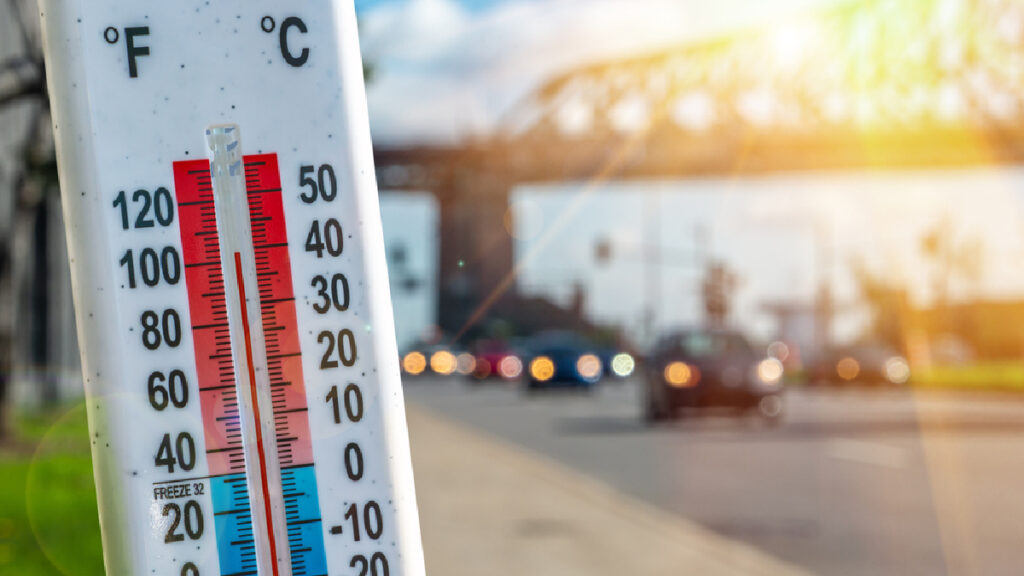Last Updated on June 10, 2024 by Kristin

The United States has seen historically high temperatures this summer, which can create challenges for drivers — especially if you’re in an unfamiliar rental car. While there’s no truth to the myth that tires can melt in extreme heat, they are more vulnerable to other problems in very high temperatures. Here are tips for driving in extreme heat.
Ensuring your tire pressure is properly set is essential. Elevated tire pressure can make your tires more susceptible to punctures and blowouts.
Consider your roadside assistance options. Before setting out on a road trip, it’s a smart idea to consider what would happen if you have car trouble. Most industry insiders will tell you that the rental car companies’ roadside protection plans are a really bad deal for consumers. If you have a membership with AAA or another auto club, you can use it if needed.
Ask AutoSlash for a Quote on a Cheap Car Rental
Rather than call a local tow service, you might save money by using a pay-per-use platform like Urgent.ly or the Honk app, which are affordable and fast.
Check your tires before leaving the rental car office. It’s easy to assume that the rental agency is checking the condition of rental car tires after every dropoff. But often that’s not necessarily the case. In fact, over the years, multiple AutoSlash customers have told us that they had gotten a flat while renting a car because the tires were in bad condition.
One of the easiest tricks is to use a penny to check the tire tread depth. The so-called “penny test” is quick and simple. Turn a penny so that Abraham Lincoln’s head is facing down. Now, insert it into the tread of a tire. If any of Abe’s head disappears into the tread, the tires are fine. But if you can still see Lincoln’s entire head, the tire treads are too worn.
Make sure the air conditioning works. While you’re at it, give your air conditioning a test run before you head off, too. If it’s not cooling you down sufficiently, ask for another vehicle.
Check your tire pressure frequently. For auto shops, summer is known as “tire blowout season.” Heat can increase tire pressure quickly. For every 10-degree (Fahrenheit) rise in temperature, your tires gain 1 PSI (pound per square inch) in pressure. For every 10-degree drop, your tires lose about 1 PSI pressure. Very high temperatures cause the air pressure in your tires to increase to a point where it can cause an explosion. Overinflation of tires can also interfere with braking. If you are driving through a very hot place, check your tire pressure every 75 miles.
You might assume that it’s safer to drive with underinflated tires in hotter months, but that strategy can backfire. Without proper air pressure, the tire’s internal components — including steel, composites, and rubber — flex more. Driving with underinflated tires can cause internal damage to the tire, making it weaker and more susceptible to a blowout. The goal is to keep tire pressure at a Goldilocks-approved “just right.”
Avoid potholes. You probably try to avoid potholes no matter how hot it is outside, but you want to be especially eagle-eyed when temperatures soar. In extreme heat on a worn tire, the great impact of a pothole can cause your tire to die a slow death from slowly releasing air over time or, worse, cause a blowout right then and there. A really bad pothole can also cause damage to your wheels and suspension.
Watch for signs your car is overheating. When your car’s temperature moves above the halfway mark on the dashboard, consider pulling over for a brief period (in an air-conditioned space, ideally) so that you can give your engine a break.
Let AutoSlash Track Your Car Rental for Price Drops
If you spot steam, call for roadside assistance. If there is smoke, pull over and get away from the car. Be very careful opening the hood of an overheated car, and don’t add coolant or water until the car cools down.
Never leave any person or pet in a parked car. Within just 10 minutes of parking your car on a 90-degree day, the interior temperature can hit 110 degrees. Don’t leave sleeping kids or pets in a parked car, even for just a few minutes, and always pack plenty of water for the trip. Remember, the back of the car and cargo areas of many cars don’t get as much air as the front seats, so make sure to keep everyone hydrated and check on pets often.
Think twice before choosing an electric car. Perhaps a long road trip through the desert isn’t the right vacation to rent an electric car. In general, EVs don’t like extreme temperatures, whether very high or very low. Either extreme can reduce the charge of your battery by as much as 40%.
Related:




